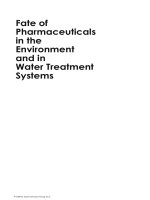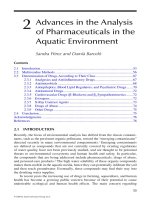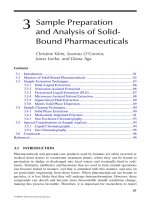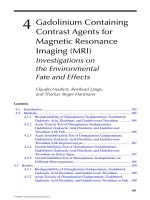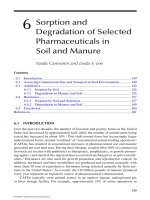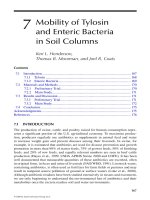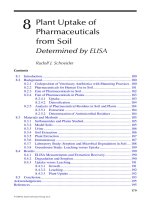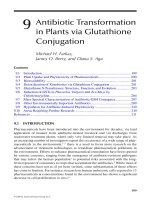Fate of Pharmaceuticals in the Environment and in Water Treatment Systems - Chapter 11 docx
Bạn đang xem bản rút gọn của tài liệu. Xem và tải ngay bản đầy đủ của tài liệu tại đây (798.43 KB, 31 trang )
229
11
Removal of Endocrine
Disruptors and
Pharmaceuticals during
Water Treatment
Shane A. Snyder, Hongxia Lei, and Eric C. Wert
11.1 INTRODUCTION
Over the past decade a great amount of interest has arisen regarding the occurrence
andfateoftraceorganiccontaminantsintheaquaticenvironment.Ofparticular
concern are human hormones and pharmaceuticals, many of which are ubiquitous
contaminants in conventional municipal wastewater treatment plant efuents when
measured with ng/L detection limits. As analytical procedures and bioassay tech-
niques become more readily available and increasingly sensitive, new contaminants
will be discovered. The presence or absence of any chemical in a wastewater efu-
entisessentiallyafunctionofanalyticaldetectioncapability.Thisposesaunique
challengefordrinkingwatertreatmentplantsintentontheremovaloforganiccon-
taminants,ascompleteremovalismerelyareectionofreportinglimits.Theproj-
ect described in this chapter was designed to investigate the attenuation of a group
of structurally diverse emerging contaminants by conventional and advanced water
treatment processes.
Contents
11.1 Introduction 229
11
.2 Background 230
11.3 Selection of Target Compounds 232
11.4 Analytical Methods 234
11.5 Bench-Scale Evaluations 235
11.5.1 Bench-Scale Experimental Procedures 235
11.5.2 Results from Bench-Scale Studies 237
11.6 P ilot-Scale Evaluat ions 245
11.6.1 Pilot-Scale Experimental Procedures 245
11.6.2 Results from Pilot-Scale Studies 246
11.7 Full-Scale Evaluations 249
11.8 Conclusion 252
Ack nowledg ments 254
References 255
© 2008 by Taylor & Francis Group, LLC
230 Fate of Pharmaceuticals in the Environment and in Water Treatment Systems
Thesedatarepresentaportionofthendingsfromastudysponsoredbythe
American Water Works Association Research Foundation (AwwaRF) entitled
“Removal of EDCs and Pharmaceuticals in Drinking and Reuse Processes” (Project
#2758). This project sought to determine the treatment efcacy of various processes
atbench,pilot,andfullscalefortheremovalofemergingcontaminantsbymonitor
-
in
g the concentration decrease of the parent compounds. Reaction byproducts and
thecorrespondingstructuralchangeswerebeyondthescopeofthisstudy;however,
oxidative processes generally do not result in appreciable mineralization, and reac-
ti
on byproducts are expected. This chapter focuses on ndings related to oxidation,
magnetic ion-exchange, and activated carbon. For the sake of brevity, experiments
using Colorado River water (CRW) will be the highlight of this chapter while noting
AwwaRF Project 2758 investigated several natural waters.
This study shows that the majority of emerging contaminants can be readily
oxidized using ozone or ultraviolet (UV)-advanced oxidation. Free chlorination
effectively removed more target compounds than chloramination. Magnetic ion-
exchange (MIEX
®
)providedminimalcontaminantremoval;however,contaminants
that were negatively charged at ambient pH were well removed. Activated carbon,
bothinpowderedandgranularforms,waseffectiveforcontaminantadsorption.
Carbontype,contacttime,anddoseorregenerationareinuentialparametersin
removal efcacy by activated carbon. Although not discussed in this chapter, tight
membrane ltration (reverse osmosis and nanoltration) was more effective than
loose membrane ltration (ultraltration and microltration). No single treatment
process was capable of removing all contaminants consistently to below the analyti
-
cal method reporting limit. Moreover, each treatment process provided advantages
and disadvantages that will be discussed in this chapter. A multibarrier approach
wouldprovidethemostcomprehensiveremovalstrategyforthetreatmentoforganic
contaminants.
11.2 BACKGROUND
In 1965, Stumm-Zollinger and Fair of Harvard University published the rst known
report indicating that steroid hormones are not completely eliminated by wastewater
treatment.
1
In an article published in 1970, Tabak and Bunch investigated the fate of
human hormones during wastewater treatment and stated “since they (hormones) are
physiologically active in very small amounts, it is important to determine to what
extent the steroids are biodegraded.”
2
As early as the 1940s, scientists were aware
that certain chemicals had the ability to mimic endogenous estrogens and andro-
gens.
3,4
In 1977 researchers from the University of Kansas published the rst known
reportspecicallyaddressingthedischargeofpharmaceuticalsfromawastewater
treatment plant.
5
Despitetheseearlyndings,theissueofsteroidsandpharmaceu-
ticals in wastewater outfalls did not gain signicant attention until the 1990s, when
the occurrence of natural and synthetic steroid hormones in wastewater was linked
toreproductiveimpactsinshlivingdownstreamofoutfalls.
6–8
Since the initial link between trace contaminants (sub-µg/L) in wastewater efu-
entsandecologicalimpactsinreceivingwaters,manystudieshavefocusedonthe
occurrence of these contaminants.
9–17
As a result, pharmaceuticals and steroid hor-
moneshavebeendetectedinmanywaterbodiesaroundtheworld.
16,18,19
One major
© 2008 by Taylor & Francis Group, LLC
Removal of Endocrine Disruptors and Pharmaceuticals 231
contributor of such widespread contamination is municipal wastewater discharge,
whichimpactssurfacewaterqualitybycontaminatingreceivingwaterbodieswith
chemicals not completely removed by current wastewater treatment processes. Indi
-
rect potable water reuse, either planned or unplanned, can occur when wastewater
treatment plant discharge comprises a signicant portion of the receiving stream’s
totalow.Insomecases,efuent-dominatedsurfacewatersareusedassource
watersfordrinkingwatertreatmentfacilities.Globalwatersustainabilitydepends
in part upon effective reuse of water. In particular the reuse of municipal wastewater
is critical for irrigation and augmentation of potable water supplies. However, public
perception and concern regarding trace hormones and pharmaceuticals has gener
-
ate
dresistancetoreuseprojects.Itisnecessarytoobtainaccurateinformationon
the elimination of these contaminants from wastewater, the impact of wastewater
dischargeonsurfacewaterorgroundwaterdrinkingwatersupplies,andtheremoval
efciencyoftheremainingcontaminantsbyconventionalandadvanceddrinking
water treatment processes.
Asignicantnumberofarticleshaveinvestigatedthefateoftracehormonesand
pharmaceuticals through water treatment processes.
13,20–33
The ability of a particular
treatment process to remove organic contaminants depends mostly on the structure
andconcentrationofthecontaminant.Inaddition,theoperationalparametersof
the process (e.g., oxidant dose and contact time) will also determine the degree of
attenuation of a particular contaminant.
Tixier et al. studied the concentration variation of six pharmaceuticals in waste
-
w
at
er efuent and river waters.
34
The concentration proles of these contaminants in
thewatercolumnofalakeinSwitzerlandweremeasuredover3months.Phototrans-
f
o
rmation, adsorption, and biodegradation were identied as the main elimination
processes for these contaminants in the lake water. Loraine and Pettigrove reported
the occurrence of pharmaceuticals and personal-care products in raw drinking water
at four water treatment plants impacted by sewage treatment plant efuent.
35
Some
compounds were detected in nished drinking water, demonstrating that the treat-
m
e
ntprocessesemployedwerenotcapableofcompleteremovalofalltracecon-
t
a
minants. The concentrations in raw water showed high seasonal variations during
lowandhighowconditionsinoneofitstwosourcewaters.Temperaturechange
can also result in seasonal variation of pharmaceuticals, as observed in Finland at a
drinking water plant that was impacted by wastewater.
36
The treatment efciency of pharmaceuticals was evaluated in a few full-scale
treatment facilities. Results obtained from one with two-stage coagulation, followed
by granular activated carbon (GAC) ltration and chlorine disinfection, have con
-
rmedpreviousndingsfromlaboratoryinvestigations,
36
where pharmaceuticals
werepoorlyremovedbycoagulation,whileGACwasveryefcientinremoving
these contaminants.
25,32,37
Anotherteaminvestigatedaconventionalfull-scaledrink-
ing water treatment plant, consisting of coagulation, ltration, and disinfection for
the treatment efciency of organic contaminants. Pharmaceuticals and other waste
-
wat
er-related organic contaminants were monitored during low ow conditions.
38
Fortyofthemonitoredcompoundsweredetectedinraworsourcewaterandseveral
were detected in nished water, suggesting some contaminants were persistent and
demonstrated the inefciency of commonly employed treatment processes.
© 2008 by Taylor & Francis Group, LLC
232 Fate of Pharmaceuticals in the Environment and in Water Treatment Systems
To date, the number and type of organic contaminants investigated are still lim-
ited considering the large pool of undetected chemicals. The sparse information on
the occurrence and removal efciency of many yet-to-be investigated organic con-
ta
minants stimulated the work presented in this chapter, which was performed at
both bench and pilot scales, and subsequently evaluated by full-scale investigations.
11.3 SELECTION OF TARGET COMPOUNDS
Target compounds were selected from various classications of organic contami-
nants. Classes included pharmaceuticals, hormones, personal-care products, sus-
pected endocrine disruptors, and other model compounds. Pharmaceuticals were
selected to encompass several therapeutic classications including: antibiotics,
analgesics, birth control, psychoactive drugs, and cholesterol-lowering medications.
Target compounds included seven hormones that represent both estrogens and andro
-
ge
ns.Severalsuspectedendocrinedisruptors,includingatrazineandtriclosan,were
also included. These compounds present a diverse group of chemical structures, such
that the fate of future contaminants can be predicted based upon their structure. Four
primarycriteriawereconsideredduringtheselectionprocess.
Therstcriterionwaslikelihoodofoccurrenceintheenvironment.Previous
publications from peer-reviewed journals and government reports were considered.
Pharmaceuticals have been identied in surface waters, groundwaters, and wastewa
-
te
rs in the United States, Europe, Asia, and other continents around the world.
35,39–44
Among these, the nationwide occurrence surveys conducted byU.S.G
eologicalSur-
vey(USGS)draw themostattention,forwhichpharmaceuticalscompriseasig-
nicant portion of the contaminants investigated.
16,45
These reports were considered
during the initial selection process to warrant the inclusion (or rejection) of various
candidate contaminants.
Thesecondcriterionwastoxicologicalrelevanceandpublicinterest.Pharma-
ce
uticals were selected based on concerns over long-term, low-dose exposure, which
have been implicated as a possibility in increased antibiotic resistance and allergic
reactions.
46–48
Steroids were considered because they are biologically active at low
concentrationsandfrequentlyincludedinmanystudiesduetoseriousconcernof
theirestrogeniceffecttoaquaticspecies.
Thethirdcriterionwasstructuraldiversityandtreatability.Thisisreectedby
thewiderangeofmolecularweight(MW),watersolubility(S),octanol/waterpar
-
ti
tioningcoefcient(logK
ow
), and acidic/basic properties (Table 11.1). The removal
of each compound is intrinsically linked to its chemical structure and the particu-
la
r treatment process. For instance, phenolic compounds are amenable to oxidation
treatment and hydrophobic compounds can readily adsorb to GAC. An herbicide, a
pesticide, two fragrances, and a ame retardant were included to increase structural
diversity. This breadth of chemical structure ensures a reasonable span of treatability
foranobjectiveevaluationofeachunitprocess.
The fourth and nal criterion was analytical capability. The limiting factors
are the availability of analytical standards and method performance for specic
compounds with analytical equipment available. Compounds for which puried
standards were not commercially available were not included. Signicant quanti
-
ti
es of compounds were required in order to conduct the spiked batch and dynamic
© 2008 by Taylor & Francis Group, LLC
Removal of Endocrine Disruptors and Pharmaceuticals 233
treatmentstudies.Somecompoundscouldnotbeconsideredduetoalackof,orthe
costof,availablestandards.Sinceallcompoundswereintendedtobeextractedbya
single solid-phase extraction (SPE) method, some analytes could not be accommo
-
dated with the operational parameters considered.
49
TABLE 11.1
Physicochemical Properties of Selected Pharmaceuticals*
Compounds Classes CAS MW S (mg/L) Log K
OW
pKa
Acetaminophen Analgesic 103-90-2 151.2 1.40E+4 0.46 9.38
Androstenedione Hormone 63-05-8 286.4 57.8 2.75 na
Atrazine Herbicide 1912-24-9 215.7 34.7 2.61 1.7
Caffeine Psychoactive 58-08-2 194.2 2.16E+4 –0.07 10.4
Carbamazepine Psychoactive 298-46-4 236.3 18
50
2.45 13.9
51
DEET** Insect repellant 134-62-3 191.3 9.9
52
2.18 0.7 (est)
Diazepam Psychoactive 439-14-5 284.7 50 2.82 3.4
Diclofenac Analgesic 15307-86-5 296.2 2.37 4.51 4.15
Dilantin Psychoactive 57-41-0 252.3 32 2.47 8.33
Erythromycin Antimicrobial 114-07-8 733.9 1.44 (est) 3.06 8.88
Estriol Hormone 50-27-1 288.4 441 (est) 2.45 9.85 (est)
Estradiol Hormone 50-28-2 272.4 3.6 4.01 10.4
53
Estrone Hormone 53-16-7 270.4 30 3.13 10.4
53
Ethynyl estradiol Hormone 57-63-6 296.4 11.3 3.67 10.4
54
Fluoxetine Psychoactive 54910-89-3 309.3 60.3 (est) 4.05 10.3 (est)
Galaxolide Fragrance 1222-05-5 258.4 1.75
55
5.9
55
na
Gembrozil Antilipidemic 25812-30-0 250.3 19 (est) 4.33 (est) 4.42
Hydrocodone Analgesic 125-29-1 299.4 6870 (est) 2.16 (est) 8.35 (est)
Ibuprofen Analgesic 15687-27-1 206.3 21 3.97 4.91
Iopromide x-ray contrast
agent
73334-07-3 791.1 23.8 (est) –2.05 10.2 (est)
Meprobamate Psychoactive 57-53-4 218.3 4700 0.7 10.9 (est)
Metolachlor Pesticide 51218-45-2 283.8 530 3.13 na
Musk ketone Fragrance 81-14-1 294.3 0.46,
56
1.9
57
4.3
56
na
Naproxen Analgesic 22204-53-1 230.3 15.9 3.18 4.15
Pentoxifylline Vasodilator 6493-05-6 278.3 7.70E+4 0.29 1.49 (est)
Progesterone Hormone 57-83-0 314.5 8.81 3.87 na
Sulfamethoxazole Antimicrobial 723-46-6 253.3 610 0.89 5.5
58
TCEP*** Flame retardant 115-96-8 285.5 7000 1.44 na
Testosterone Hormone 58-22-0 288.4 23.4 3.32 na
Triclosan Antimicrobial 3380-34-5 289.5 10 4.76 7.9
59
Trimethoprim Antimicrobial 738-70-5 290.3 400 0.91 7.12
*Unless indicated, all are experimental values from Environmental Science Database SRC PhysProp
** Chemical name: N,N-diethyl-meta-toluamide
*** Chemical name: Tri(chloroethyl)phosphate
© 2008 by Taylor & Francis Group, LLC
234 Fate of Pharmaceuticals in the Environment and in Water Treatment Systems
Table 11.1 provides the list of target compounds discussed in this chapter follow-
ing the aforementioned selection criteria. Also summarized in this table are the com-
pound classication and molecular properties pertinent to water treatment processes.
These particular properties provide information on molecular size, hydrophobicity,
and molecular charge under ambient pH.
11.4 ANALYTICAL METHODS
One-liter samples were collected in silanized amber glass bottles for bench-, pilot-,
andfull-scaleinvestigations.SampleswerepreservedbyadjustingthepHto2for
microbialactivitycontrolandascorbicacidwasusedtoquenchdisinfectantresid-
ual.
17
ThepHadjustmentwasfoundimportanttopreventthebiodegradationofcer-
tain steroids and the pharmaceuticals trimethoprim, acetaminophen, and uoxetine.
17
Grab samples were taken by personnel from each utility with general water qualities
monitoredsimultaneously.Foreachplant,atleastonesitewasselectedfordupli-
ca
tesamples(usuallytherawwater)forqualitycontrol.Additionally,travelblanks,
laboratoryblanks,andmatrixspikeswerepreparedwitheachsamplingevent.The
sampleswereshippedbacktothelaboratoryinanice-packedcoolerbyovernight
express shipping.
Allsampleswereextractedinbatchesofsixsamplesusingautomated-SPE
(ASPE) utilizing 500-mg hydrophilic-lipophilic balance (HLB) cartridges from
Waters Corp. (Millford, Massachusetts). Cartridges were sequentially precondi
-
ti
oned by methyl tertbutyl ether (MTBE),met hanol, and reagent water. The absorbed
analytes were then eluted with 10/90 (v/v) methanol/MTBE solution and pure metha-
nol,followedbyconcentrationtoavolumeof1mLwithnitrogen.
Pharmaceuticals, hormones, and atrazine were analyzed by liquid chromatogra-
phy
with tandem mass spectrometric detection (LC-MS/MS) using electrospray ion-
ization (ESI) in both positive and negative modes and atmospheric pressure chemical
ionization (APCI) in positive mode following a method published previously.
17
The remaining chemicals were analyzed by gas chromatography with tandem
mass spectrometric detection (GC-MS/MS).
49
The same SPE procedure was used;
however,aportionoftheresultingextractwasremovedandreextractedusingdichlo-
romethaneinordertoremovecompoundsthatinterferewithGC-MS/MSanalysis.
49
Method performance in terms of instrument detection limits (IDLs) and spiked
recoveries remain unchanged from previously published work.
17,49
The spike recov-
eries of most target compounds were generally above 70% for LC-MS/MS and above
60% for GC-MS/MS analysis with the exception of acetaminophen and galaxolide
(41% and 30%, respectively). A conservative method reporting limit (MRL) of 1
ng/LformostLC-MS/MScompoundsand10ng/LforGC-MS/MScompoundswas
established for this method. While concentrations are reported without adjustment
for the recovery, all treatment data are shown as percent removal through a treatment
process. The percent removal is not impacted by analytical recovery, since the recov
-
e
r
ywasconstantinboththe“raw”and“nished”waterofeachprocess.
© 2008 by Taylor & Francis Group, LLC
Removal of Endocrine Disruptors and Pharmaceuticals 235
11.5 BENCH-SCALE EVALUATIONS
11.5.1 B
ENCH-SCALE EXPERIMENTAL PROCEDURES
Evaluation of contaminant oxidation by chlorine, chloramine, ozone, and UV, and
adsorptionbyGACandMIEXwasperformedusingColoradoRiverwater(CRW)
spikedwith100to300ng/Lofeachofthetargetcompounds.Thespikingconcentra-
ti
on was selected such that removal to the MRL would provide approximately 2-log
removal(99%).ExperimentalconditionsforevaluationaresummarizedinTable11.2.
T
heCRWquality,assampledfromtheSouthernNevadaWaterAuthorityintakesin
LakeMead,isrelativelystablewithaveragevaluesprovidedinTable1 1.3.
Ch
lorination experiments were performed using liquid sodium hypochlorite
(NaOCl, Fisher Scientic,Pittsburgh,P
ennsylvania).Stock solutionsofchlorinewere
initiallypreparedindeionized(DI)waterat1200mg/L.Chlorinewasdoseddirectly
into 1-L bottles containing the source water. Chlorine doses were determined based
uponthechlorinedemandinordertoachievearesidualgoalofapproximately0.5
mg/L after 24 hours. Free chlorine residuals were measured by the N,N-diethyl-p-
phehylenediamine (DPD) Method using a Hach DR4000 spectrophotometer (U.S.
Environmental Protecton Agency [USEPA]-approved Hach Method #8021, Hach
Company, Loveland, Colorado). Experiments were conducted at ambient water pH
and at a suppressed pH of 5.5. After the 24-hour contact time, residual chlorine was
quenched with 50 mg/L of ascorbic acid. Analytical surrogates sensitive to chlo
-
ri
newereaddedjustpriortosolid-phaseextraction;therefore,analyticalrecovery
of these surrogates provided denitive information on whether or not the chlorine
residual was quenched.
Chloramineexperimentswereperformedbyrstaddingammoniatoa1-Lsam
-
pl
e of raw water followed by sodium hypochlorite addition. Stock solutions of each
chemical were created from 29% ammonium hydroxide (J.T. Baker, Phillipsburg,
N
ewJersey)an d5%s
odium hypochlorite (NaOCl, Fisher Scientic). A chlorine:
ammoniaratioof4:1wastargetedbecausethisiscommonlyusedindrinkingwater
treatment. This sequence of chemical addition was selected over preformed mono-
ch
loramine solution to closely simulate actual water treatment plant conditions. The
TABLE 11.2
Experimental Matrix for Bench-Scale Studies
Tests Dosage Contact Time
Ozone 2.5 mg/L 5 min
Free chlorine 3, 3.5 mg/L 24 hr
UV 40 mJ/Cm
2
Chloramine 2, 3 mg/L 24 hr
MIEX 5, 15, 20 mL/L 10 min
GAC n/a 7.6 min EBCT*
*
EBCT: Empty bed contact time.
© 2008 by Taylor & Francis Group, LLC
236 Fate of Pharmaceuticals in the Environment and in Water Treatment Systems
experiments were conducted at room temperatures (approximately 20°C) at ambient
pH.Thechloramineresidualwasquenchedwithascorbicacidusingaratioof20:1
ascorbic acid:chlorine.
Ozone experiments were conducted by injecting a high concentration of dis
-
so
lvedozoneintoa1-Lsamplebottlecontainingthesourcewater.Dissolvedozone
stocksolutionwaspreparedbydissolvingahighconcentrationofgaseousozoneinto
DI water at 2°C. Dissolved ozone stock solution concentrations and dissolved ozone
residuals were measured spectrophotometrically using the indigo method (Standard
Methods 4500-O
3
). The ozone dose was determined using an ozone demand/decay
curvegeneratedfortheCRW.
30
MIEXisaprocessthatutilizesmagneticpolymermicrospheresasanion
exchange resin. The resin is composed of a polymer and inorganic magnetic mate-
ri
als such as Fe
3
O
4
,Fe
2
O
3
,nickel,andcobaltsothattheresinexhibitsthechar-
acteristics of both ionic exchange and magnetism in order to achieve rapid and
improvedseparationforregenerationandrecycle.MIEXresin(OricaWatercare,
Inc.,Watkins,Colorado)fromanon-sitepilotplantprovidedtheresinforthejar
testing. Gravity separation of the resin is very efcient because of the “magneti
-
ca
lly” enhanced agglomeration of individual resin beads that yields resin settling
againsttherapidlyrisingwaterinthesettler.SincetheMIEXresinusedforbench-
scaletestingwascycledseveraltimesthroughthepilotsystem,thebindingcapacity
waslikelydecreased,andwasmorerepresentativeofaresinthatwouldbeinservice
TABLE 11.3
Average Water Quality of Colorado River
Water
Water Quality
Parameter
Average Minimum Maximum
pH 7.79 7.68 7.99
Temperature (
o
C) 21 20 22
Turbidity (NTU) 0.73 0.35 1.5
UV254 (1/cm) 0.029 0.025 0.037
Alkalinity (mg/L) 133 131 134
Bromide (mg/L) 0.08 0.05* 0.10
Chloride (mg/L) 84 75 94
Hardness (mg/L) 288 260 310
Sulfate (mg/L) 246 230 250
SUVA 1.2 —
—
TDS (mg/L) 619 602 642
TOC (mg/L) 3.23 2.9 3.4
* Below method reporting level.
© 2008 by Taylor & Francis Group, LLC
Removal of Endocrine Disruptors and Pharmaceuticals 237
ascomparedtovirginmaterial.MIEXconcentrationsof5,15,and20mL/Lwere
evaluated with a 10-minute contact time. These experiments mimicked conditions
used during previous pilot testing.
60
Bench-scale testing was conducted using rapid small-scale column tests
(RSSCTs) to predict GAC performance. A detailed description of these tests was
published previously.
31
The RSSCT design used constant diffusivity similitude,
wheretheratioofemptybedcontacttimeisproportionaltothesquareoftheratioof
the grain diameters.
61
Constant diffusivity similitude was selected because Critten-
denandothershavefoundthistobemoreappropriatethanproportionaldiffusivity
for“smaller”molecularweightdiscretemoleculesthatdonothaveahighcharge.
61
Proportionaldiffusivityhasbeenfoundmostappropriatefornaturalorganicmat-
te
rwithanaveragemolecularweightof1000Daltonsorhigher,whichalsohasa
considerable charge, and for highly charged inorganic species such as perchlorate.
62
Moreover,constantdiffusivityisthemore“conservative”similitudetouse(i.e.,if
RSSCTexhibitsthatanorganicmoleculewillberemovedwithinacertainbedlife
whenusingconstantdiffusivity,thenthepredictedbedlifeatfullscalewillbethe
same or longer). Tests were performed with the lignite-based GAC Hydrodarco 4000
(HD4000)manufacturedbyNorit.Inaccordancewithconstantdiffusivitysimili
-
tudeforthetargetcompounds,acolumnwith0.307-cm
3
empty bed volume was
utilized with the test carbons crushed and wet-sieved to 75 to 90-μm particle size
(170 × 200 US mesh). With this design, RSSCTs simulated a full-scale column that
operatesata7.6-minuteemptybedcontacttime(EBCT).CRWwasspikedwith
100to200ng/Lofthetargetcompounds.Thetestcolumnwasmaintainedatroom
temperature between 20 and 25ºC.
UV bench-scale experiments were conducted using a collimated beam system
equipped with medium pressure lamp (Calgon Carbon Corporation, Pittsburgh,
Pennsylvania). Aliquots of spiked CRW (500 mL) were irradiated in a 600-mL glass
beakeronamagneticstirplatecenteredwithrespecttothelightbeam.Sampleswere
irradiated for predetermined periods of time corresponding to selected UV uences
(UV dose). Irradiance measurements were collected with a 1700 International Light
Research Radiometer with SED40 detector, calibrated at each wavelength within
a200-to340-nmrange.UVuenceswerecalculatedusingaspreadsheetbased
on the incident irradiance, sample geometry, and water absorption spectrum, as
described elsewhere.
63
During advanced oxidation experiments, hydrogen peroxide
wasadded1minutepriortoexposure,and
r
esiduals were quenched with 0.2 mg/L
bovine catalase.
11.5.2 RESULTS FROM BENCH-SCALE STUDIES
ThecomparisonsfortheremovaloftargetanalytesbyUV,freechlorine,andozone
are presented in Figure 11.1 t
hroughFigure 11 .5, according to compound classi-
cations.Overall,UVisnotabletoprovidesignicantremovaltomosttargetana-
ly
tesunderacommondisinfectiondoseof40mJ/cm
2
. Free chlorine disinfection is
signicantly more efcient than UV disinfection for contaminant removal, while
ozone disinfection can oxidize nearly all target compounds investigated. It should be
© 2008 by Taylor & Francis Group, LLC
238 Fate of Pharmaceuticals in the Environment and in Water Treatment Systems
notedthatnoprocesswascapableofremovingalltargetcompoundstolessthanthe
method reporting limits.
TwoprincipalmechanismsforcontaminantremovalbyUVirradiationarepos-
sible.First,UVcandirectlycleavebondsinorganicmoleculesbydirectphotolysis
ofthetargetmolecule.Second,UVreactswithinorganicconstituentsinwaterto
form highly reactive intermediates, with the formation of hydroxyl radicals (HO
•
)
0 20406080100
Trimethoprim
Triclosan
Sulfamethoxazole
Erythromycin
% Removal
UV 40 mJ
Ozone 2.5 mg/LChlorine 3.5 mg/L
FIGURE 11.2 Removal of antimicrobials by UV, chlorine, and ozone.
0 20406080100
Ethynylestradiol
Estrone
Estriol
Estradiol
Progesterone
Androstenedione
Testosterone
% Removal
UV 40 mJ
Ozone 2.5 mg/LChlorine 3.5 mg/L
FIGURE 11.1 Removal of hormones by UV, chlorine, and ozone.
© 2008 by Taylor & Francis Group, LLC
Removal of Endocrine Disruptors and Pharmaceuticals 239
contributingtotheoxidationoforganiccompounds.Inthiscase,thetotalenergy
deliveredbyUVlampisrelativelylowandexplainstheminimalremovalobservedat
disinfection dosages. This nding is consistent with a study conducted by Rosenfeldt
andLindenwhoexaminedthedegradationof17
B-ethynyl e
stradiol and 17C-estradiol
%&" $!'#( !'#
FIGURE 11.3 RemovalofpsychoactivecompoundsbyUV,chlorine,andozone.
0 20406080100
Acetaminophen
Hydrocodone
Ibuprofen
Diclofenac
Naproxen
% Removal
UV 40 mJ
Ozone 2.5 mg/LChlorine 3.5 mg/L
FIGURE 11.4 Removal of analgesic pharmaceuticals by UV, chlorine, and ozone.
© 2008 by Taylor & Francis Group, LLC
240 Fate of Pharmaceuticals in the Environment and in Water Treatment Systems
viaUVandUV/hydrogenperoxideprocessesusingeitherlow-ormedium-pressure
arclampcollimatedbeamreactors.
64
Low degradation yields were reported for both
compounds,rangingfrom2to5%,orfrom15to22%,ataUVdoseof1000mJ/cm
2
deliveredbyalow-oramedium-pressurelamp,respectively.Thechemicalstructure
ofthetargetanalytecontrolswhetheritcanbeoxidizedbyUVlight.Theconjugated
aromatic structure in diclofenac and triclosan causes these two compounds to exhibit
relatively higher removal.
Chlorine mostly reacts via electrophilic substitution and addition. Functional
groupsarecriticalindeterminingacompound’sreactivitywithchlorine.Chlorine
can also act as an oxidant, by reacting selectively with electron rich bonds of organic
chemicals(e.g.,C=Cbondsinaromaticring).Electrondonatingsubstituentsin
organic molecules tend to increase reactivity, while electron withdrawing groups
decrease reactivity.
25,33,65,66
Allfourantimicrobialsandfouroftheveanalgesics
showedcompleteremovalbyfreechlorineduetotheirelectrondonatingsubstitu-
ents (
Figure 11.2 andFigure 11. 4).Phenolicsteroids(e.g.,estradiol,estrone,estriol,
and ethynyl estradiol) were readily oxidized by chlorine, while ketone steroids (e.g.,
testosterone and progesterone) were not effectively oxidized (
Figure 11.1). The r
apid
reactions of phenolic compounds with free chlorine are mainly through the elec-
tr
ophilic attack of hypochlorous acid to the deprotonated phenolate anion.
67,68
Psy-
choactivecompoundswereremovedbylessthan20%,whiletheremovalofmodel
compoundsrangedfromnoremovaltoover90%consistentwiththeirstructure
diversity intentionally included for objective evaluation.
0 20406080100
Gemfibrozil
Pentoxifylline
Iopromide
TCEP
Musk Ketone
Galaxolide
Metolachlor
Atrazine
DEET
% Removal
UV 40 mJ Ozone 2.5 mg/LChlorine 3.5 mg/L
FIGURE 11.5 RemovalofmodelcompoundsbyUV,chlorine,andozone.
© 2008 by Taylor & Francis Group, LLC
Removal of Endocrine Disruptors and Pharmaceuticals 241
Free chlorine is present in the form of either hypochlorite ion or hypochlorous
acid(HOCl)withapK
a
of7.5.SoHOCldominatesatpH<7.5andOCl
–
constitutes
ahigherpercentageatpH>7.5.HOClisgenerallyconsideredastrongeroxidizing
and substituting agent than OCl
-
.
69
Theoxidativepowerofaqueouschlorinehighly
dependsonpH.ResultssummarizedinF
igure11.6conrmedthispoint.Theremoval
capabilityoffreechlorinealmostdoubledwhenpHdecreasedfrom8.2to5.5.
Chloramineintheformofmonochloramineiscommonlyusedforthedistribu
-
ti
onsystemindrinkingwatersuppliestomaintainchlorineresidual.Itismuchmore
stablethanfreechlorineandexhibitslesstendencytoformchlorinateddisinfec
-
ti
onbyproducts(DBPs).Bench-scaletestingresultsindicatedthatchloramineisless
potentinremovingtargetcontaminants.Mosttargetcompoundswerelessthan10%
removedby2or3mg/Lofchloramineafter24hoursofcontacttime(Figure11
.7).
Only triclosan, diclofenac, and hydrocodone were removed by 30 to 90%, all of
whichweresusceptibletobothfreechlorineandozoneoxidation.Thissuggeststhat
chloramineisnotaviableoptionwhenconsideringtheremovaloftraceamountsof
pharmaceuticals.
Oz
oneisastrongoxidantanddisinfectantthatdecayswithinminutesafter
itsadditiontowater.Ozonereactswithorganiccontaminantseitherthroughthe
direct reaction with molecular ozone or through oxidation by free radicals, including
the hydroxyl radical (HO
•
).Duringozonationtests,mostofthetargetcompounds
investigated showed over 80% removal at typical drinking water dosages and were
removedwithin5minutesofcontacttim
e(Figure11.1t
hroughFigure 11.5). As
expected,electron-donatinggroupsenhancethereactivityofaromaticcompounds
towardozone,whileelectron-withdrawinggroupsinhibitthereactivity.Asaresult,
pH 8.2 pH 5.5
0 20406080100
Testosterone
Progesterone
Pentoxifylline
Meprobamate
Ibuprofen
Gemfibrozil
Dilantin
Diazepam
Carbamazepine
Androstenedione
% Removal
FIGURE 11.6 ImpactofpHonoxidationbychlorine(3.5mg/L).
© 2008 by Taylor & Francis Group, LLC
242 Fate of Pharmaceuticals in the Environment and in Water Treatment Systems
alltargetcompoundswithphenolicstructures,suchasacetaminophen,andseveral
hormoneswereremovedtobelowanalyticaldetectionlimits(Figure11.8 ). A n
um-
ber of compounds have also exhibited complete removals (carbamazepine, gemi-
brozil, hydrocodone, diclofenac, erythromycin, naproxen, sulfamethoxazole, and
trimethoprim) due to their increased afnity to electrophiles (ozone in this case)
from highly conjugated systems and/or multiple electron-donating substituents. The
concentrations of musk ketone and tris(2-chloroethyl) phosphate (TCEP)wereo
nly
decreasedby12%and30%,respectively. Androstenedione,progester one, and t
es-
tosteronewereoxidizedlessefcientlythananyoftheestrogencompoundsdueto
ketone functional groups on these hormones, which decreases the reactivity of ozone
with the adjacent carbons.
During MIEX bench testing most compounds showed less than 20% removal
whenusingacontacttimeof10minutes.Theremainingcompoundsshowedadose
response related to the MIEX concentration
(Figure 11.9). Only t
riclosan and diclofe-
nacwereremovedbygreaterthan50%,bothofwhichwerenegativelychargedattest
pHandfavoredbytheanionicexchange.Whenthecontacttimewasincreasedto20
minutes, the same group of target compounds again showed less than 20% removal
(data not shown). The remaining compounds showed slightly higher removal at the
increased contact time.
60
Activated carbon (AC) removes organic contaminants via adsorption. The acti-
vationprocessforthemanufactureofACcreateshighlyporousmaterialswithadis-
tributionofporesizesandsurfaceareasthatpromoteshydrophobicinteractionwith
0 20406080100
Gemfibrozil
Trimethoprim
Erythromycin
Sulfamethoxazole
Naproxen
Hydrocodone
Diclofenac
Triclosan
% Removal
Chloramine 2 mg/L
Free Chlorine 3 mg/LChloramine 3 mg/L
FIGURE 11.7 Comparison of chloramine and free chlorine oxidation.
© 2008 by Taylor & Francis Group, LLC
Removal of Endocrine Disruptors and Pharmaceuticals 243
organiccontaminants.Thosecontaminantswithlowaqueoussolubility,andasize
conducive to tting within the pore structure, are most readily adsorbed. In drink-
ing water treatment, the concentration and type of natural organic matter (NOM)
in the source water will compete with organic contaminants for surface adsorp-
ti
on sites, reducing the effectiveness of the AC.
70–72
Figure 11.10 demonstrates that
GACishighlyeffective;however,water-solublecontaminantscanbreakthrough
the GAC more rapidly than strongly bound hydrophobic contaminants. The removal
of neutral compounds was correlated with their octanol-water partition coefcients
(K
ow
). This is logical since adsorption of neutral compounds on AC is dominated
by hydrophobic interactions, for which K
ow
is a good indicator. However, K
ow
was
Phenolic Structure
Acetaminophen Estradiol Estrone
HO
H
N
O
HO
H
CH
3
OH
H
H
HO
H
CH
3
O
H
H
CH
3
Highly Conjugated System/Electron Donating Substituent
Carbamazepine Gemfibrozil Hydrocodone
Resistant to Oxidation
Ketone Structure
TCEPMusk Ketone
ProgesteroneAndrostenedione Testosterone
N
H
3
C
CH
3
CH
3
CH
3
H
3
C
N
H
O
O
OH
3
C
O
O
OH
O
O
O
N
N
Cl
Cl
Cl
O
O
O
O
OH
P
O
–
O
–
O
H
3
C
H
3
C
CH
3
CH
3
CH
3
CH
3
CH
3
CH
3
CH
3
CH
3
CH
3
H
3
C
H
H
H
H
H
H
H
H
H
H
CH
3
H
2
N
O
O
O
O
O
FIGURE 11.8 Chemical structures of some endocrine disruptors and pharmaceuticals.
© 2008 by Taylor & Francis Group, LLC
244 Fate of Pharmaceuticals in the Environment and in Water Treatment Systems
generally not a good indicator for deprotonated acids or protonated bases, because
most reported K
ow
values are for the neutral form of the molecules. For these species,
the octanol–water distribution coefcient (D
ow
) should be more appropriate to repre-
sent their hydrophobicity and relate to their removal tendency. D
ow
is the ratio of the
sum of the concentrations of all species of the compound in octanol to the sum of the
concentrations of all species of the compound in water, and its value highly depends
0 20406080100
Triclosan
Diclofenac
Naproxen
Ethynylestradiol
Dilantin
Ibuprofen
Gemfibrozil
Estradiol
% Removal
20 mL15 mL5 mL
FIGURE 11.9 Removal of selected pharmaceuticals based on different amounts of MIEX.
FIGURE 11.10 Removal using HD4000 granular activated carbon.
0.0
0.2
0.4
0.6
0.8
1.0
0 10000 20000 30000 40000 50000 60000
Bed Volumes
C/C
0
Hydrocodone
Fluoxetine
Meprobamate
DEET
Atrazine
Estrone
Sulfamethoxazole
Diclofenac
0.70
0.89
2.45
2.16
2.61
2.18
1.70
4.05
Log K
ow
© 2008 by Taylor & Francis Group, LLC
Removal of Endocrine Disruptors and Pharmaceuticals 245
on the extent of ionization. Since the experimental pKa values of these compounds
arenotreadilyavailableitisdifculttoconcludedenitivelyabouttherelevanceof
removaltoD
ow
.
11.6 PILOT-SCALE EVALUATIONS
11.6.1 P
ILOT-SCALE EXPERIMENTAL PROCEDURES
Ozone and UV with and without hydrogen peroxide were evaluated using ow-
through pilot equipment. Ozone pilot experiments were conducted at the Southern
NevadaWaterAuthorityusingCRW.UVpilotexperimentswereconductedusing
dechlorinated tap water at the Trojan UV Technologies research facility in Lon
-
do
n, Ontario, Canada. Only LC-MS/MS target compounds were evaluated during
pilot-scale experiments; therefore, galaxolide, musk ketone, and metolachlor were
not considered.
Ozonepilotsystemswithowratesof1.0L/minand23L/minweresupplied
with CRW. These pilot systems have been described in detail previously.
30
The
bench-toppilotplant(BTPP)withaowrateof1.0L/minwasusedtoconductmul-
ti
ple ozone and ozone/hydrogen peroxide oxidation experiments. The BTPP ozone
contactorconsistedof12glasschamberseachproviding2minutesofcontacttime.
TheBTPPtestingwasperformedusingtwo170-LbatchesofCRWspikedwithtar
-
ge
tcompounds.Thelargerozonepilotplant,withaowrateof23L/min,wasused
to evaluate ozone oxidation without hydrogen peroxide addition. A syringe pump
wasusedtointroducethetargetcompoundsintotheprocessstream.Twostaticmix
-
er
s followed the contaminant spike to provide homogenization. The pilot ozone con-
ta
ctorconsistedof12cellstoprovideapproximately24minutesofcontacttimeat
the design ow rate of 23 L/min.
The UV pilot contained a medium-pressure UV reactor operated through an
electronicballastsuchthatthelamppowerlevelcouldbevariedfrom30to100%,
staticmixers,anelectronicowmeter,portsforspikinghydrogenperoxideandother
solutions, sampling ports, and metering peristaltic pumps. The pilot setup contained
two41,600-Ltanks.Dechlorinateddrinkingwater(30,000L)wasspikedwith100
to200ng/Lofthetargetcompoundsinalargefeedtank,andrecirculatedfor1hour
at2840L/mintoensurethoroughmixing.UVenergiesdeliveredtothewaterwere
variedbyadjustingtheowratethroughtheUVreactor.UVuencesrequiredfor
contaminantoxidationweredeliveredusingfourlampsat60%powerlevelandow
ratesfrom416to1400L/min.WhilemultipleUVexperimentswereconductedwith
and without hydrogen peroxide, only results from experiments using hydrogen per
-
oxide (AOP) are shown here.
MIEXpilotplanttestingwasconductedusingCRWspikedwithtargetcom
-
pounds.AMIEXconcentrationof20mL/Lwasselectedastheoptimumfrom
bench-scale results. Samples were collected after each contactor chamber having
total elapsed contact times of 10 and 20 minutes.
© 2008 by Taylor & Francis Group, LLC
246 Fate of Pharmaceuticals in the Environment and in Water Treatment Systems
11.6.2 RESULTS FROM PILOT-SCALE STUDIES
Results from ozone BTPP experiments are presented in Figure11.11andFig-
ure 11.12.Ozonewasfoundtobehighlyeffectivefortheremovalofmosttarget
compoundsevenatrelativelylowozonedoses.Figure11.11andFigure11.12show
onlycompoundsforwhichremovalswereincomplete; therefore,compoundsnot
shownwereremovedtolessthantheMRL.Compoundsarepresentedinorderof
removalefcacy,withTCEPthemostdifculttooxidize.OnlyTCEP,atrazine,
meprobamate,andiopromidehadremovalefcaciesoflessthan50%atthelowest
ozonedoseapplied(Figure11.11). Theadditionof0.25mg/Lhydrogenperoxide
withanozonedoseof1.3mg/Lresultedinasignicant(>10%)decreaseinremoval
ofmeprobamate, iopromide, N,N-diethyl-m-toluamide(DEET), dilantin,andibu-
profen(Figure11.11). Converselytheadditionofhydrogenperoxideincreasedthe
removalofandrostenedione,progesterone,testosterone,caffeine,andpentoxifylline.
Atanincreasedozonedoseof2.7mg/L,removaloftargetcompoundsincreased.
However,theadditionof0.5mg/Lhydrogenperoxideshowedasimilartrendaswith
thelowerdose,yetthedegreeofimpactwaslessdramatic(Figure11.12).Results
fromthe23-L/minpilotwereremarkablysimilartothoseobtainedusingtheBTPP
(Figure 11.13).
TargetcompoundsnotremovedtolessthantheMRLwiththelowestmedium-
pressure UV-AOP dose are shown in Table 11.4. Acetaminophen, diclofenac,
estradiol, estrone, ethynyl estadiol, hydrocodone, naproxen, and triclosan were all
removedtolessthantheMRLusingeventhelowestUV/hydrogenperoxidedose(216
mJ/cm
2
to 4.6 mg/L). Carbamazepine, TCEP, meprobamate, and erythromycin were
FIGURE 11.11 Bench-top ozone pilot plant removal—low dose.
!
#
"
"
,"&('+ ,"&('+%*
,
&)'+
$-.
© 2008 by Taylor & Francis Group, LLC
Removal of Endocrine Disruptors and Pharmaceuticals 247
!
#
"
"
,"&)'+
,"&'+%*
,
&('+
$-.
FIGURE 11.12 Bench-top ozone pilot plant removal—high dose.
0 20406080100
Triclosan
TCEP
Meprobamate
Iopromide
Ibuprofen
Dilantin
Diazepam
DEET
Atrazine
% Removal
Bench PilotBTPP
FIGURE 11.13 Impactofscalingatanozonedoseof2.5mg/Lobtainedwiththe23-L/min
pilot system.
© 2008 by Taylor & Francis Group, LLC
248 Fate of Pharmaceuticals in the Environment and in Water Treatment Systems
the only target compounds with less than 50% reduction at the minimum UV-AOP
dose applied (Table 11.4).AconstantU
Vdoseofapproximately370mJ/cm
2
was
appliedwithhydrogenperoxidedosesof5.8and7.6mg/L.Interestingly,theincrease
inhydrogenperoxideataconstantUVdosedidnotofferalargeincreaseincontami
-
na
ntremoval.IncreasingtheUVdosetoapproximately540mJ/cm
2
with a hydrogen
peroxide dose of 7.5 mg/L showed a modest increase in contaminant oxidation. These
data demonstrate diminishing returns with large increases in UV and hydrogen per
-
ox
ide doses, suggesting that lower doses may provide nearly equivalent contaminant
reductionwithlessenergyandperoxidecost.ContaminantremovalbyUV-AOPand
ozone-AOPappeartobehighlycorrelated,aswouldbeexpectedastheseprocesses
both induce the formation of the less selective, yet highly potent, hydroxyl radical.
Resultsconsistentwithbench-scaletestingwereobtainedduringMIEXpilot
plant testing. Triclosan and diclofenac were the only two compounds removed by
over50%withboth10and20minutesofcontacttime.Slightlyhigherremovals
wereobservedforprogesteroneandestroneduringpilot-scaleexperiments.How
-
ev
er, the general trend in which the compounds were removed was similar to the
bench-scale testing results.
TABLE 11.4
Medium-Pressure UV-AOP Pilot
UV Dose (mJ/cm
2
) 216 366 379 537
Peroxide Dose (mg/L) 4.6 5.8 7.6 7.5
Percent Removal (%)
Androstenedione 81 83 89 96
Atrazine 61 61 67 80
Caffeine 66 68 76 89
Carbamazepine 16 49 67 >88
DEET 64 67 78 89
Diazepam 73 74 81 93
Dilantin 84 86 91 97
Erythromycin 0 35 19 64
Fluoxetine 92 93 96 >98
Gembrozil 76 78 85 95
Ibuprofen 73 74 83 94
Iopromide 76 80 79 91
Meprobamate 48 45 58 75
Pentoxifylline 68 68 78 90
Progesterone 84 86 91 98
Sulfamethoxazole 95 97 97 >99
TCEP 10 0 8 16
Testosterone 83 85 90 97
Trimethoprim 76 77 85 94
© 2008 by Taylor & Francis Group, LLC
Removal of Endocrine Disruptors and Pharmaceuticals 249
11.7 FULL-SCALE EVALUATIONS
Samplesofrawandnisheddrinkingwaterwerecollectedfrom20drinkingwater
treatmentplantsfromgeographicallydiverselocationsacrosstheUnitedStates.
Treatment plants were selected based upon known wastewater inuence in the source
water. Therefore, these utilities have the highest potential to contain EDC/PPCP
compounds, making them good candidates for evaluating efciencies of full-scale
treatmentprocess.SummaryresultsfromdrinkingwaterEDC/PPCPmonitoringare
presented in
Table11.5andT
able 11.6. These two tables show the number of detec-
tions above the MRL (detects), percent frequency of detection (% freq), minimum
(min),maximum(max),median,andaverage(ave).Itisimportanttonotethatthe
min, max, median, and ave values are calculated only from detectable values, thus
values less than the MRL are not factored into the ave reported. Diazapem, diclof
-
en
ac, estradiol, ethynyl estradiol, uoxetine, pentoxifylline, and testosterone were
notdetectedinanyoftherawornishedwatersamplesevaluated.
TABLE 11.5
Concentrations of Target Compounds in Source Waters
(n = 20)
Compound Detects
%
Freq.
Min
(ng/L)
Max
(ng/L)
Median
(ng/L)
Ave
(ng/L)
DEET 20 100 2.8 28 6.9 9.0
Carbamazepine 18 90 1.2 39 3.1 6.2
Dilantin 18 90 1.1 13 3.2 3.5
Atrazine 17 85 1.3 571 28 101
Sulfamethoxazole 17 85 1.2 44 8.1 14
Ibuprofen 16 80 1.1 24 4.2 6.1
Meprobamate 16 80 1.4 16 5.9 7.0
TCEP 15 75 2 66 13 18
Caffeine 14 70 9.1 87 27 34
Iopromide 14 70 2.2 46 7.6 12
Gembrozil 13 65 1.2 11 4.8 5.2
Naproxen 10 50 1.1 16 2.2 5.7
Erythromycin 8 40 1 3.5 2.2 2.2
Acetaminophen 7 35 1.1 9.5 1.6 2.7
Metalochlor 7 35 11 174 15 71
Triclosan 6 30 1 30 1.9 6.4
Galaxolide 3 15 25 30 28 28
Musk Ketone 3 15 14 17 16 16
Trimethoprim 3 15 1 2.3 2.2 1.8
Estrone 2 10 1 1.4 1.2 1.2
Androstenedione 1 5 1.9 1.9 1.9 1.9
Hydrocodone 1 5 1.9 1.9 1.9 1.9
Progesterone 1 5 1.1 1.1 1.1 1.1
© 2008 by Taylor & Francis Group, LLC
250 Fate of Pharmaceuticals in the Environment and in Water Treatment Systems
Inbothrawandnisheddrinkingwatersamples,N,N-diethyl-m-toluamide
(DEET)hadhighestfrequencyofoccurrence(100and90%,respectively).TheU.S.
Environmental Protection Agency (EPA) has estimated that approximately one third
of the U.S. population uses DEET-containing products ( />ci
des/ factsheets/chemicals/deet.htm). The pharmaceuticals carbamazepine and
dilantinweredetectedin90%ofrawwatersampleswithmaximumconcentrationsof
39and13ng/L,respectively.Innisheddrinkingwater,carbamazepineanddilantin
were less frequently detected (55 and 70%, respectively) with maximum concentra
-
ti
onsof5.7and6.7ng/L,respectively.Thesedatashowthatdrinkingwatertreatment
will signicantly reduce the concentrations of these pharmaceuticals. Atrazine was
detected at the greatest concentration in drinking waters. Atrazine was detected in
85%ofrawwatersand75%ofnishedwaters,withmaximumconcentrationsof
571and430ng/L,respectively.Drinkingwatertreatmentprocessesevaluatedhere
werelargelyineffectivefortheremovalofatrazine,withtheexceptionofactivated
carbon.Theantibioticsulfamethoxazoleoccurredin85%ofrawwatersamplescol
-
le
cted,butwasonlydetectedinonenisheddrinkingwatersample.Thisfacility
had40ng/Lofsulfamethoxazoleintherawwaterand20ng/Linthenishedwater,
thus50%ofthisantibioticwasremovedthroughtheplant.Thepoorremovalatthis
facilitycanbeexplainedbytheuseofchloraminesforprimarydisinfection,which
wasshowntobemuchlessreactivewithsulfamethoxazolethanfreechlorine(
Fig-
ure 11.6). The ph
armaceuticalsibuprofenandmeprobamateandthex-raycontrast
TABLE 11.6
Emerging Contaminants in U.S. Drinking Water (n = 20)
Compound Hits
%
Freq
Min
(ng/L)
Max
(ng/L)
Median
(ng/L)
Ave
(ng/L)
DEET 18 90 2.1 30 5.1 8.2
Atrazine 15 75 1.4 430 29 74
Meprobamate 15 75 1.6 13 3.8 6.1
Dilantin 14 70 1.1
6.7 2.3 2.7
Ibuprofen 13 65 1 32 3.8 7.9
Iopromide 13 65 1.1 31 6.5 8.5
Caffeine 12 60 2.6 83 23 25
Carbamazepine 11 55 1.1
5.7 2.8 2.8
TCEP 7 35 3 19 5.5 10.1
Gembrozil 5 25 1.3
6.5 4.2 3.9
Metalochlor 4 20 14 160 86 86
Estrone 2 10 1.1
2.3 1.7 1.7
Progesterone 2 10 1.1
1.1 1.1 1.1
Erythromycin 1 5 1.3
1.3 1.3 1.3
Musk
Ketone 1 5
17 17 17 17
Naproxen 1 5 8 8 8 8.0
Sulfamethoxazole 1 5 20 20 20 20
Triclosan 1 5 43 43 43 43
Trimethoprim 1 5 1.3
1.3 1.3 1.3
© 2008 by Taylor & Francis Group, LLC
Removal of Endocrine Disruptors and Pharmaceuticals 251
mediaiopromidearecompoundsthatwerefounddifculttoremovebyconventional
water treatment processes. These compounds were detected in over 65% of the raw
and nished drinking waters evaluated, with only small amounts removed during
treatment. The antimicrobial triclosan was detected in 30% of the raw water samples
atlowconcentrationsrangingfrom1to30ng/L,whileitwasdetectedinonlyone
nished water sample at 45 ng/L. The facility that contained the highest level of tri-
cl
osanintherawwateralsocontainedtheonlydetectionoftriclosaninthenished
water.Thisutilitywasalsotheonlylocationwithsulfamethoxazoledetectedinthe
nishedwater.Bothtriclosanandsulfamethoxazolehaverapidremovalwhenin
contactwithchlorineorchloramines;therefore,thenishedwatersampleclearly
hadalowamountofcontacttimewithchloraminebeforetheoxidantwasquenched.
Thesyntheticfragrancesmuskketoneandgalaxolideweredetectedinonly2ofthe
20rawwatersamplesanalyzed,andonlymuskketonewasdetectedinonenished
waterat17ng/L.
While steroid hormones seem to garner the greatest amount of concern regard-
in
gpublichealthfromregulatoryagencies,thesecompoundswererarelydetected
inU.S.drinkingwaters.Estronewasdetectedintworawwatersamplesat1.0and
1.4ng/Landintwonishedwatersat1.1and2.3ng/L.Thesevaluesarenearthe
MRLof1.0ng/L.Progesteroneandandrostenedionewereeachdetectedinoneraw
water,eachatlessthan2ng/L,whileprogesteronewasdetectedtwiceat1.1ng/Lin
nished water.
Removalefcacyofindividualunitprocessesalsowasevaluated.Ingeneral,
coagulation,occulation,andltrationhadverylittleimpactontargetcompound
removalatfullscale(datanotshown).However,disinfectionplayedamajorrole
in contaminant removal.Table 11.7 s
howstheremovalofcompoundsbychlorine
disinfectionatfullscale.Ingeneral,predictedremovalatbenchscaleagreedwell
withobservationsatfull-scaleutilities.Onlycompoundsdetectedat2×theMRLare
showninTable11.7inordertodeterminepercentremoval.Compoundsthatappear
todeviatefromthebench-scalepredictionsaregenerallythosewithoccurrencenear
the2×MRLthreshold.RemovalbyUVdisinfection,ozonedisinfection,andGAC
atfull-scaleutilitiesareshowninTable 11.8 throughTable 11.10.Aspredictedat
benchscale,UVdisinfectionwaslargelyinefcient,whileozonedisinfectionwas
highlyefcientfortracecontami nant removal. M
oreover, full-scale GAC proved
to be effective for contaminant removal as long as the GAC was replaced or regen-
erated on a regular basis.
31
Conversely,activatedcarbonhasalimitedservicelife
for contaminant adsorption and will become completely ineffective for contaminant
removal.
31
Powderedactivatedcarbonisalsoaviableoptionfororganiccontaminant
removal,andresultsspecictothesetargetcompoundshavebeenpublished.
33
The
resultsshownheredepicttheoverallremovalthroughtheprocessanddonotaccount
for differences in dose, contact time, or water quality. Interestingly, the trends from
bench-scale predictions are in good agreement with full-scale observations even
with the variability in operational process parameters. Although not shown here,
full-scale treatment plants using reverse osmosis membranes effectively removed all
target analytes, while membrane ltration using ultraltration and microltration
was generally ineffective for contaminant rejection.
31
© 2008 by Taylor & Francis Group, LLC
252 Fate of Pharmaceuticals in the Environment and in Water Treatment Systems
Summarily,theseresultsshowthatremovaloftracecontaminantsinafull-scale
drinkingwatertreatmentplantwilllargelybeafunctionoftheprimarydisinfectant,the
secondary disinfectant, and contact time. Carbon adsorption and membranes are also
viableremovaltools,butarefarlesscommonindrinkingwatertreatmentapplications.
11.8 CONCLUSION
Theuseofoxidantsfortheattenuationoftracecontaminantsoffersaneconomi-
callyviableoptionforwatertreatmentsystems.Itisimportanttonotethateventhe
strongest oxidation techniques investigated do not result in complete mineralization
(oxidation to carbon dioxide and water) at the doses investigated. Therefore, oxida
-
ti
on byproducts will be produced and should be considered. However, the concentra
-
ti
on of natural organic matter will be orders of magnitude greater in concentration as
compared to pharmaceuticals, endocrine disruptors, and other trace contaminants.
The oxidation byproducts of organic carbon should be considered collectively, as
thereisafargreaterprobabilityofformingtoxicbyproductsfrommg/LofNOMas
compared to ng/L of trace contaminants. Both ozone and UV-AOP processes tend to
form less aromatic and more biodegradable oxidation products.
32,73–75
More research
is needed to determine the fate of these byproducts in subsequent adsorption and
TABLE 11.7
Full-Scale Removal Using Free Chlorine
# Utilities
Observed Percent Removal
Bench-Scale
Predicted>80 50–80 20–50 <20
Acetaminophen 1 1 >80
Atrazine 10 1 9 <20
Caffeine 8 2 6 <20
Carbamazepine 8 1 1 3 3 <20
DEET 12 1 11 <20
Dilantin 8 3 5 <20
Erythromycin 3 2 1 >80
Estrone 1 1 >80
Galaxolide 2 2 20–50
Gembrozil 5 2 1 1 1 50–80
Ibuprofen 8 2 6 <20
Iopromide 8 5 2 <20
Meprobamate 8 8 <20
Metolachlor 4 4 <20
Naproxen 4 4 >80
Sulfamethoxazole 7 6 1 >80
TCEP 5 4 <20
Triclosan 1 1 >80
Trimethoprim 2 2 >80
© 2008 by Taylor & Francis Group, LLC
Removal of Endocrine Disruptors and Pharmaceuticals 253
TABLE 11.8
Full-Scale Removal Using UV Disinfection
(Approximately 40 mJ/cm
2
)
Facility A
% Rem
Facility B
% Rem
Facility C
% Rem
Bench-Scale
% Rem
Acetaminophen >44 NA NA 50–20
Atrazine 4 <1 <1 <20
Caffeine 42 <1 <1 <20
Carbamazepine >17 NA <1 <20
DEET 22 19 <1 <20
Dilantin 15 NA <1 <20
Erythromycin <1 NA <1 <20
Galaxolide
9 >23 8 <20
Gembrozil 69 NA <1 <20
Ibuprofen <1 <1 <1 <20
Iopromide <1 NA <1 <20
Meprobamate <1 <1 <1 <20
Sulfamethoxazole >83 NA <1 80–50
TCEP
5 <1 <1 <20
NA = Not applicable; % Rem = %Removal
TABLE 11.9
Full-Scale Removal with GAC
Compound
Facility A
% Rem
Facility B
% Rem
Facility C
% Rem
Atrazine >99 5.9 NA
Caffeine >41 36 <1
Carbamazepine >54 NA <1
DEET >44 38 10
Dilantin >44 NA 29
Estradiol NA >84 NA
Erythromycin >44 NA NA
Galaxolide NA >9 NA
Gembrozil >16 NA NA
Ibuprofen >9 >58 52
Iopromide >69 <1 14
Meprobamate >16 NA 16
Metolachlor >91 NA NA
Sulfamethoxazole >83 NA NA
TCEP NA NA 40
NA = Not applicable; % Rem = %Removal
© 2008 by Taylor & Francis Group, LLC
